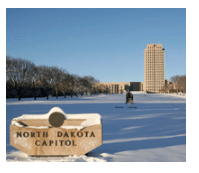North Dakota Senate Kills Mid-Level Provider Bill
In North Dakota, the combination of a shortage of dentists and lack of access to affordable care means that many people have never seen an oral health professional
 In North Dakota, the combination of a shortage of dentists and lack of access to affordable care means that many people have never seen an oral health professional. In fact, 40% of North Dakota counties are served by only one dentist or do not have a dentist at all. To improve access to care for all North Dakotans, Senate Bill 2354 was introduced by Senator Dick Dever (R-Bismarck) to establish advanced-practice dental hygienists (APDH). The bill was defeated in the Senate on February 23, with a vote of 40 to 6.
In North Dakota, the combination of a shortage of dentists and lack of access to affordable care means that many people have never seen an oral health professional. In fact, 40% of North Dakota counties are served by only one dentist or do not have a dentist at all. To improve access to care for all North Dakotans, Senate Bill 2354 was introduced by Senator Dick Dever (R-Bismarck) to establish advanced-practice dental hygienists (APDH). The bill was defeated in the Senate on February 23, with a vote of 40 to 6.
Rachelle Gustafson, RDH, president of the North Dakota Dental Hygienists’ Association, was one of the organizers of the charge to introduce mid-level providers to the state. She told Dimensions of Dental Hygiene that “the bill was a collaborative effort between many groups who are concerned with the dental health in the state.”
At present, 50 developed countries and several states support the mid-level dental practitioner model, the success of which has provided a solid body of evidence for its potential to reach underserved populations. SB 2354 incorporated similar standards as existing mid-level provider programs, including the ability of the APDH to identify oral and systemic conditions requiring evaluation and/or treatment by dentists; comprehensive charting of the oral cavity; dispensing and administering certain medications; pulp vitality testing; fabrication of sports mouthguards; simple extraction of erupted primary teeth; fabrication and placement of single-tooth temporary crowns; and indirect and direct pulp capping. APDHs would have provided these services while under the supervision of a dentist.
The APDH model was designed to improve access to affordable, routine dental care for North Dakota’s underserved populations, including rural residents, Native Americans, older adults, and Medicaid and Medicare patients. “APDHs could bring care to where people are, including rural communities, nursing homes, schools, reservations, and assisted-living facilities,” said Dever. “Certifying new mid-level providers is a common sense solution to increasing access to affordable, routine dental care for all North Dakotans.”
The bill was opposed by the North Dakota Dental Association and the state Board of Dental Examiners, who cited concerns about patient safety and the feasibility of implementing educational programs to train mid-level providers in the state as reasons for their objection. Opponents of the bill note that other legislation should be introduced to attract more dentists to North Dakota.
From Dimensions of Dental Hygiene. March 2015;13(3):13–14.

